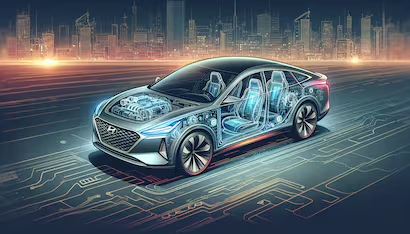In the rapidly evolving landscape of automotive technology, Hyundai has positioned itself as a frontrunner in innovation. Looking forward to 2024, Hyundai has set ambitious goals and embraced cutting-edge technologies to redefine the driving experience. This article delves into Hyundai’s strategic initiatives, technological advancements, and their vision for the future of automotive technology.
Hyundai’s Strategic Focus Areas
1. Electric Vehicles (EVs) and Sustainability
Hyundai has committed significant resources to enhance its electric vehicle lineup. By 2024, Hyundai aims to expand its range of electric vehicles with improved battery technology and increased driving ranges. The company is leveraging advancements in battery efficiency and charging infrastructure to address consumer concerns about range anxiety.
– Example: The Hyundai Ioniq 5, launched in 2021, showcases Hyundai’s commitment to EVs with a focus on design, sustainability, and advanced technology integration.
2. Autonomous Driving and AI Integration
Autonomous driving technology remains a cornerstone of Hyundai’s future strategy. By 2024, Hyundai plans to introduce Level 3 autonomous driving capabilities in select models, allowing for hands-free driving under specific conditions. This push towards autonomous driving is backed by Hyundai’s investment in artificial intelligence (AI) and machine learning to enhance safety and convenience.
– Case Study: Hyundai’s partnership with Aptiv resulted in the development of a production-ready autonomous driving platform, set to debut in upcoming models.
3. Connectivity and IoT
Hyundai envisions a seamlessly connected driving experience with enhanced vehicle-to-everything (V2X) communication capabilities. By integrating Internet of Things (IoT) technologies, Hyundai aims to improve vehicle safety, efficiency, and user experience. This connectivity extends beyond the vehicle to smart infrastructure, creating a cohesive ecosystem.
– Statistics: According to Hyundai’s internal data, over 70% of new Hyundai vehicles sold in 2024 will be equipped with advanced connectivity features.
Also Read : Anticipating the Arrival of Hyundai’s Upcoming Cars in 2024
4. Advanced Materials and Sustainability
In line with global sustainability goals, Hyundai is exploring innovative materials for vehicle construction. By 2024, Hyundai plans to integrate more sustainable materials into their vehicles, reducing environmental impact without compromising on safety or performance.
– Example: Hyundai’s use of bioplastics and recycled materials in interior components is a step towards achieving their sustainability targets.
Technological Advancements
1. Augmented Reality (AR) HUDs
Hyundai is at the forefront of integrating augmented reality into vehicles, enhancing driver visibility and safety. By 2024, Hyundai aims to introduce AR head-up displays (HUDs) that project navigation, hazard alerts, and other critical information directly onto the windshield, improving situational awareness.
– Future Vision: Hyundai’s concept vehicles showcase advanced HUDs that can overlay real-time information about road conditions and nearby vehicles, enhancing driver confidence.
2. Advanced Driver Assistance Systems (ADAS)
Hyundai continues to refine its ADAS capabilities to offer enhanced safety features and driver assistance. By 2024, Hyundai plans to deploy next-generation ADAS technologies that incorporate AI for predictive capabilities, adaptive cruise control, and advanced collision avoidance systems.
– Statistics: Hyundai reports a significant reduction in accident rates among vehicles equipped with ADAS, underscoring the effectiveness of these technologies.
3. Vehicle-to-Everything (V2X) Communication
Hyundai is investing in V2X communication to enable vehicles to interact with each other and their surroundings. By 2024, Hyundai vehicles will leverage V2X capabilities to enhance traffic management, improve emergency response times, and optimize navigation routes based on real-time data.
Use Case: Hyundai’s pilot projects in smart cities demonstrate the potential of V2X technology to reduce congestion and improve overall urban mobility.
Hyundai’s Collaboration and Partnerships
1. Partnership with Technology Giants
Hyundai has forged strategic partnerships with technology giants such as Nvidia and Qualcomm to integrate their advanced computing platforms into Hyundai vehicles. These collaborations accelerate the development of AI, autonomous driving systems, and advanced infotainment solutions.
– Example: Hyundai’s collaboration with Nvidia has resulted in the development of the ‘Drive’ platform, which powers Hyundai’s autonomous driving systems.
2. Collaboration with Startups and Innovation Hubs
Hyundai actively engages with startups and innovation hubs to foster creativity and accelerate the pace of technological innovation. By collaborating with startups specializing in AI, robotics, and mobility solutions, Hyundai stays agile and responsive to emerging trends in the automotive industry.
– Case Study: Hyundai’s partnership with Boston Dynamics explores the integration of robotics and mobility solutions for enhanced vehicle functionalities.
Conclusion
As Hyundai looks ahead to 2024, the company’s commitment to technological innovation is evident across its product lineup and strategic initiatives. By focusing on electric vehicles, autonomous driving, connectivity, and sustainability, Hyundai aims to redefine the automotive industry’s future. Through strategic partnerships and a relentless pursuit of innovation, Hyundai is poised to deliver cutting-edge technologies that enhance safety, efficiency, and user experience in vehicles.
Hyundai’s vision for 2024 not only promises to transform the driving experience but also reflects its dedication to sustainability and technological leadership in the global automotive market.
This comprehensive article explores Hyundai’s ambitious plans and technological advancements slated for 2024, providing valuable insights into the future of automotive technology.
(source)
Originally posted 2024-07-11 07:15:20.
